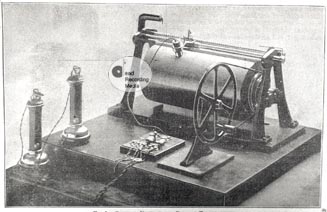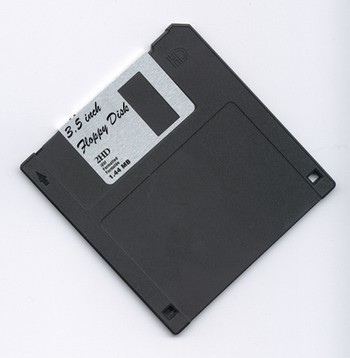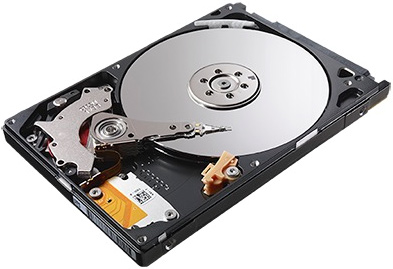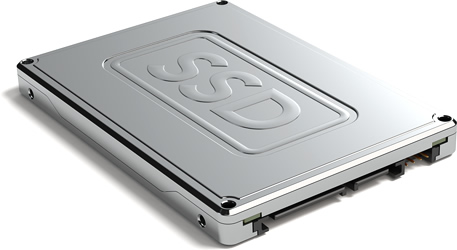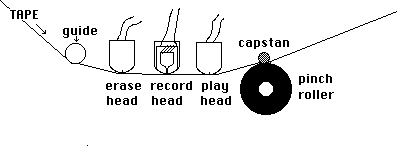Memory Storage Devices
--Lee Dong Hyun dlee682 (talk) 19:06, 5 December 2015 (EST)
Magnetic storage devices use the method of magnetic recording to preserve data.
Magnetic recording
Magnetic recording is a process where portions of a magnetic material are selectively magnetized with the use of electrical signals.
History of recording devices
As technology improved significantly over time, a wide number of recording devices have been introduced.
Telegraphone
The first use of this kind of technique was introduced by a Danish engineer Valdemar Poulsen in 1900. He created a machine called telegraphone that allowed him to record speech magnetically on a steel wire, and this became the start of many storage devices that are existent today. After the introduction, he continued to develop the technology and improved the sound quality through the use of direct current onto the recording head. However, the signals were weak and difficult to amplify, with the quality of the product highly fluctuating and thus unreliable.
Magnetophone
The Magnetophone was developed in Germany in the 1930s, when other kinds of magnetic recorders were being developed in countries such as Britain, USA, and Japan. It started from Ludwig Blattner, who bought the rights of the steel tape device and modified it into the Blattnerphone. The magnetophone an improved version of the existing telegraphone in that it was portable and it contained its own amplifier and speaker. Also, it no longer used the highly unreliable steel wire and used reels of acetate tape and magnetite coating. Further improvements down the line replaced the use of DC currents to AC currents, which allowed production of a 60 dB dynamic range of sound.
VTR (Videotape recorder)
The videotape recorder was the next greatest innovation in the recording industry, as it was the first machine which allowed recording of video onto a tape. However, it didn't become popular until the cassette format was introduced by Sony in the 1970s, which revolutionized the videotape industry. Improvements along the line led to the development of Walkman, which was one of the greatest successes for a portable videotape recorder, distributed all over the world. According to Sony, 100 million units were sold in the U.S alone during the 20 years of Walkman devices. Walkman was the first product which was able to effectively tackle the issue of inconsistency in quality, and was extremely convenient in its portability.
Floppy disk
As far as the computer industry is concerned, one of the most significant developments of the 1970s was the floppy disk. The introduction of the floppy disk from IBM perfectly matched the emergence of microprocessors from Intel, making them complimentary products. The first versions of the floppy disk could hold up to 800 KB, and became a necessity for many people who used computers and had to transfer data in a portable mode. The most improved versions of the floppy disk held up to 1200 KB.
HDD (Hard Disk Drive) and SSD (Solid State Drive)
The two most advanced versions of data storage available today are hard disk drives and solid-state drives. Hard disk drives became a necessary component for computer users, with the primary features being capacity and performance. The most recent hard disk drives can store data more than 1TB (=1000GB), and can store, read and transfer data at a very high speed. Solid-state drives are very competitive when it comes to reliability, as the flash memory the device uses have very rapid access speed of data. Hard disk drives, however, has a lower price-per-bit as compared to SSD.
How it works
The main physics behind magnetic recording involves specific patterns of magnetization on a track which corresponds to specific signals to be stored. The signals triggers the magnetization of the material as it passes through the recording device, and the remnants of the magnetization are the codes which become the basis of the storage of the data. To retrieve the data stored, the reverse process happens: the magnetization is detected by the reader which reproduces the signal that initially triggered the magnetization. The two earliest versions of this recording were longitudinal recording and perpendicular recording.
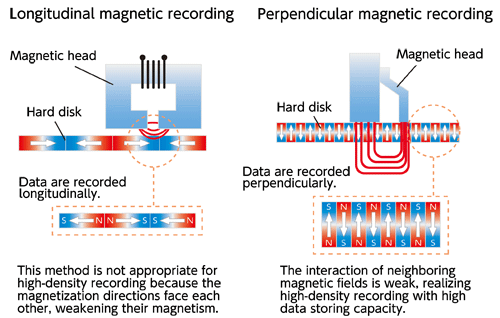
Recording methods
Analog Recording
Analog recording was the most popular method used when tapes were the most prevalent recording devices. The tape would run at a constant speed, and the writing head magnetizes the tape in response to the signals required to record a particular piece of data. Once a magnetization distribution is completed to store the relevant data, this distribution can be read out to replay the original signal which triggered the magnetization. The commonly used magnetic particles for this method are Iron oxide particles or Chromium oxide.
Digital Recording
Digital recording can be considered a more advanced method of recording, as instead of creating a magnetization distribution, digital recording makes use of magnetic states. The method involves the usage of two stable magnetic states, which are the +Ms and the -Ms on a hysteresis loop. This converts into a binary code of 0 and 1 to construct a data of existence/non-existence of signal in the particular area of recording medium. This is a technique which is used to create devices such as floppy disks and the currently popular hard disk drives.
References
"Magnetic Recording | Electronics." Encyclopedia Britannica Online. Encyclopedia Britannica. Web. 6 Dec. 2015. <http://www.britannica.com/topic/magnetic-recording>.
"COEN 180." COEN 180. Web. 6 Dec. 2015. <http://www.cse.scu.edu/~tschwarz/coen180_04/LN/physics.html>.
"ANALOG RECORDING OF SOUND." Analog Recording. Web. 6 Dec. 2015. <http://artsites.ucsc.edu/EMS/music/tech_background/te-19/teces_19.html>.
"Basics of Digital Recording." Digital Recording. Web. 6 Dec. 2015. <http://artsites.ucsc.edu/EMS/music/tech_background/TE-16/teces_16.html>.
"SPring-8, the Large Synchrotron Radiation Facility." Novel Magnetic Material Discovered in Meteorite — SPring-8 Web Site. Web. 6 Dec. 2015. <http://www.spring8.or.jp/en/news_publications/research_highlights/no_51/>.
"The History of Magnetic Recording." The History of Magnetic Recording. Web. 6 Dec. 2015. <http://www.aes.org/aeshc/docs/recording.technology.history/magnetic4.html>.
"Inventing the Wire Recorder." History of the Wire Recorder. Web. 6 Dec. 2015. <http://www.recording-history.org/HTML/wire2.php>.
"RIP Walkman: Goodbye after 30 Years." The Guardian. Web. 6 Dec. 2015. <http://www.theguardian.com/music/musicblog/2010/oct/25/rip-walkman-30-years>.
"MCE Technologies." MCE Technologies. Web. 6 Dec. 2015. <http://store.mcetech.com/mm/merchant.mvc?Store_Code=MTOS&Screen=PROD&Product_Code=LSP500GSSD>
Anton, Shilov. "Western Digital Retains Hard Disk Drive Market Share Leadership." KitGuru RSS. Kitguru, 30 Apr. 2014. Web. 6 Dec. 2015. <http://www.kitguru.net/components/hard-drives/anton-shilov/western-digital-retains-hard-disk-drive-market-share-leadership/>.
"CHM Revolution." 3.5-inch Floppy Disk -. Computer History Museum. Web. 6 Dec. 2015. <http://www.computerhistory.org/revolution/memory-storage/8/261/1083>.
